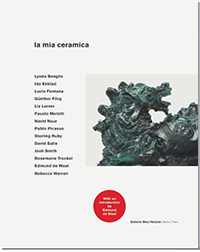Artist's Books / Special Editions
Almond, Darren: All Things Pass
Almond, Darren / Blechen, Carl: Landscapes
Brown, Glenn: And Thus We Existed
Butzer, André: Exhibitions Galerie Max Hetzler 2003–2022
Chinese Painting from No Name to Abstraction: Collection Ralf Laier
Choi, Cody: Mr. Hard Mix Master. Noblesse Hybridige
Demester, Jérémy: Fire Walk With Me
Dienst, Rolf-Gunter: Frühe Bilder und Gouachen
Dupuy-Spencer, Celeste: Fire But the Clouds Never Hung So Low Before
Ecker, Bogomir: You’re NeverAlone
Elmgreen and Dragset: After Dark
Förg, Günther: Forty Drawings 1993
Förg, Günther: Works from the Friedrichs Collection
Galerie Max Hetzler: Remember Everything
Galerie Max Hetzler: 1994–2003
Gréaud, Loris: Ladi Rogeurs Sir Loudrage Glorius Read
Grosse, Katharina: Spectrum without Traces
Hatoum, Mona (Kunstmuseum
St. Gallen)
Eric Hattan Works. Werke Œuvres 1979–2015
Hattan, Eric: Niemand ist mehr da
Herrera, Arturo: Boy and Dwarf
Hilliard, John: Accident and Design
Horn, Rebecca / Hayden Chisholm: Music for Rebecca Horn's installations
Horn, Rebecca: 10 Werke / 20 Postkarten – 10 Works / 20 Postcards
Huang Rui: Actual Space, Virtual Space
Kowski, Uwe: Paintings and Watercolors
Mikhailov, Boris: Temptation of Life
Mosebach, Martin / Rebecca Horn: Das Lamm (The Lamb)
Neto, Ernesto: From Sebastian to Olivia
Oehlen, Albert: Mirror Paintings
Oehlen, Albert: Spiegelbilder. Mirror Paintings 1982–1990
Oehlen, Albert: unverständliche braune Bilder
Oehlen, Pendleton, Pope.L, Sillman
Oehlen, Albert | Schnabel, Julian
Phillips, Richard: Early Works on Paper
Riley, Bridget: Paintings and Related Works 1983–2010
Riley, Bridget: The Stripe Paintings
Riley, Bridget: Paintings 1984–2020
Roth, Dieter & Iannone, Dorothy
True Stories: A Show Related to an Era – The Eighties
Wang, Jiajia: Elegant, Circular, Timeless
Wool, Christopher: Westtexaspsychosculpture
Zhang Wei / Wang Luyan: A Conversation with Jia Wei
 |
|
|||
La mIa ceramica English / French
|
Ceramics have long offered an additional mode of expression to painters and sculptors, installation and concept artists alike. The attraction often lies in the immediacy of clay that allows a spontaneous shaping of raw forms. This is described by Lucio Fontana in his programmatic text “La mia ceramica,” which has lent its name to the exhibition at Galerie Max Hetzler in Paris documented here. The roundup starts in the late 1940s and leads us from the pioneers of the medium—beside Fontana these are Pablo Picasso and Fausto Melotti—to very recent work from contemporary artists. You will find pure abstraction and free reinvention of vessels, spontaneous expression and calculated concept, sometimes placed within the ceramic tradition, sometimes subverting all its conventions. In its sequence of works, along with statements from the artists on the possibilities and practice of ceramics, this book reveals the very personal approaches this material affords.
La mia ceramica Clay becomes ceramic when it is fired. When clay is still in its raw state it can be broken down, mixed with water, reconstituted: objects can be made and remade indefinitely. Its plasticity is almost dangerous, it allows for revision and effacement. It has little resistance in comparison with wood or stone. Every touch is present but contingent. After firing, clay becomes other – it can be broken, chipped, made fragmentary – but it cannot return to its primal state. It is now unalterable, holding a record of the movements that made it: it is terramottata ma ferma, ‘earthquaked but motionless’, in Fontana’s vivid words. Clay and ceramic are polarised states of being, motion and stasis... Clay is inexhaustible stuff. It is cheap. It has little value in the hierarchy of materials: it is demotic, basic, primal. It is earth. As earth, it is universal but also particular as it comes out of territory, land, place. To work with it is to make something out of nothing. It is an act of Ur-creation: ‘God gave man a little bit of mud’, in Gauguin’s words. Clay records the passage of one moment of one person through the world. The use of clay to sketch, to mark in an abbreviated way the flux of feeling, is part of this map of the unexpected... Transformation takes place at different levels of seriousness, humour and complexity. But at every stage there are decisions as to whether to adopt the technics of ceramics. As Fontana said in the essay he wrote in 1939: ‘I abhor the mystics of technique… I am looking for something else.’
... |